Rosé
Rosé is a type of wine that incorporates some of the color from the grape skins, but not enough to qualify it as a red wine. It may be the oldest known type of wine, as it is the most straightforward to make with the skin contact method. The pink color can range from a pale "onion-skin" orange to a vivid near-purple, depending on the varietals used and winemaking techniques. There are three major ways to produce rosé wine: skin contact, saignée, and blending. Rosé wines can be made still, semi-sparkling, or sparkling, with a wide range of sweetness levels from highly dry Provençal rosé to sweet White Zinfandels and blushes. Rosé wines are made from a wide variety of grapes all over the world.
History[edit]
The history of rosé is likely as old as that of wine itself. The primary method of making red wine involves the use of red grape varietals where the skin of the grape is allowed to have extended contact with the juice of the grape. However, rosé is believed to be the first type of wine produced, given the simple production methods and the wide availability of light-colored grapes.
Production[edit]
There are three main methods to produce rosé wine: skin contact, saignée, and blending. The skin contact method is when the black-skinned grapes are crushed and the skins are allowed to remain in contact with the juice for a short period, typically one to three days. The saignée method, from the French word for "bleed", involves bleeding off a portion of red wine juice after it's been in contact with the skins and seeds. The blending method is uncommon and is discouraged in most wine growing regions, especially in France, where it is forbidden by law, except for Champagne.
Styles[edit]
Rosé wines can be produced in a variety of styles, from dry to sweet and from still to sparkling. The flavor profile can also vary widely depending on the grape varietal used, the winemaking technique, and the level of ripeness at which the grapes are harvested. Some common flavors noted in rosé include red fruit, flowers, citrus, and melon, with a crunchy green flavor like celery or rhubarb.
Regions[edit]
Rosé is produced in virtually all wine-growing regions of the world. However, it is particularly well known in the Provence region of France, which is considered the birthplace of modern rosé. Other notable regions for rosé production include the Loire Valley and Champagne in France, the Veneto region in Italy, and parts of California and Washington in the United States.
-
Schramsberg Vineyards
-
Ciel du Cheval Red Mountain rosé
-
Pressing Grapes (1880) by John Reinhard Weguelin
-
Zinfandel grapes
-
Pinot noir juice from press pan
-
Rosé
-
Mourvèdre and rosé juice samples
-
Several Rhône and Provence rosés
-
Nocking Point Wines Gametime Rosé
-
Sancerre rosé Wine
-
Wine grape diagram
-
Bandol rosé
Ad. Transform your life with W8MD's Budget GLP-1 injections from $75


W8MD offers a medical weight loss program to lose weight in Philadelphia. Our physician-supervised medical weight loss provides:
- Weight loss injections in NYC (generic and brand names):
- Zepbound / Mounjaro, Wegovy / Ozempic, Saxenda
- Most insurances accepted or discounted self-pay rates. We will obtain insurance prior authorizations if needed.
- Generic GLP1 weight loss injections from $75 for the starting dose.
- Also offer prescription weight loss medications including Phentermine, Qsymia, Diethylpropion, Contrave etc.
NYC weight loss doctor appointmentsNYC weight loss doctor appointments
Start your NYC weight loss journey today at our NYC medical weight loss and Philadelphia medical weight loss clinics.
- Call 718-946-5500 to lose weight in NYC or for medical weight loss in Philadelphia 215-676-2334.
- Tags:NYC medical weight loss, Philadelphia lose weight Zepbound NYC, Budget GLP1 weight loss injections, Wegovy Philadelphia, Wegovy NYC, Philadelphia medical weight loss, Brookly weight loss and Wegovy NYC
|
WikiMD's Wellness Encyclopedia |
| Let Food Be Thy Medicine Medicine Thy Food - Hippocrates |
Medical Disclaimer: WikiMD is not a substitute for professional medical advice. The information on WikiMD is provided as an information resource only, may be incorrect, outdated or misleading, and is not to be used or relied on for any diagnostic or treatment purposes. Please consult your health care provider before making any healthcare decisions or for guidance about a specific medical condition. WikiMD expressly disclaims responsibility, and shall have no liability, for any damages, loss, injury, or liability whatsoever suffered as a result of your reliance on the information contained in this site. By visiting this site you agree to the foregoing terms and conditions, which may from time to time be changed or supplemented by WikiMD. If you do not agree to the foregoing terms and conditions, you should not enter or use this site. See full disclaimer.
Credits:Most images are courtesy of Wikimedia commons, and templates, categories Wikipedia, licensed under CC BY SA or similar.
Translate this page: - East Asian
中文,
日本,
한국어,
South Asian
हिन्दी,
தமிழ்,
తెలుగు,
Urdu,
ಕನ್ನಡ,
Southeast Asian
Indonesian,
Vietnamese,
Thai,
မြန်မာဘာသာ,
বাংলা
European
español,
Deutsch,
français,
Greek,
português do Brasil,
polski,
română,
русский,
Nederlands,
norsk,
svenska,
suomi,
Italian
Middle Eastern & African
عربى,
Turkish,
Persian,
Hebrew,
Afrikaans,
isiZulu,
Kiswahili,
Other
Bulgarian,
Hungarian,
Czech,
Swedish,
മലയാളം,
मराठी,
ਪੰਜਾਬੀ,
ગુજરાતી,
Portuguese,
Ukrainian












